Opinions
 Chinese development model has alleviated concerns about nuclear safety
Chinese development model has alleviated concerns about nuclear safety
The nuclear sector in China has been experiencing significant growth across many areas. It has continued to advance its existing nuclear power program while also developing new technologies, such as small modular reactors. Recently, I visited Hainan Province in South China, where I had the opportunity to see the Linglong One, the world first commercial onshore small modular reactor, which holds enormous promise both for China and for developing countries.
What I see here is a very dynamic sector that is steadily gaining ground in the country energy mix. I am very optimistic about this.
To achieve such growth in nuclear energy, it is essential to have a very strong safety system, full adherence to...
Yuriy Chernichuk commented on reports about the possible transfer of Ukrainian nuclear power plants to the control of the United States
Statement by the Foreign Ministry regarding the latest US Sanctions against the Russian Federation
Siemens will be sued for refusing to supply paid equipment to Akkuyu-1 - Likhachev
The local side will act as the general operator in the consortium for the construction of nuclear power plant in Kazakhstan - Tokayev
IAEA is ready to send its specialists to the Kursk NPP, if necessary - Grossi
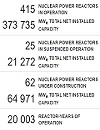 PRIS - 20 thousand reactor years
PRIS - 20 thousand reactor years
The global nuclear energy industry has reached a landmark milestone. According to the PRIS database maintained by the IAEA, the total number of reactor years of operation of nuclear power units in the world has exceeded 20 thousand.
To date, the PRIS base has 415 nuclear power units in operation. Its total installed net capacity is 373.735 GWe.
The operation of 25 power units with a total net capacity of 21.272 GWe has been suspended. Almost all of it are located in Japan (21 units), where post-Fukushima safety checks are ongoing.
62 power units with a total capacity of 64.971 GWe are under construction. The undisputed leader is China, where 28 power units are being built. It should be noted...
Cost of Kozloduy-7 construction may reach USD 20 billion - expert
Theoretical ban on the sale of uranium in the United States will not cause problems for Russia - Likhachev
 Argentina - stagnation of the program
Argentina - stagnation of the program
After President Javier Miley came to power in Argentina, the country nuclear program is facing great difficulties.
Initially, the situation did not look so serious. Among the new ministers, there were people who spoke favorably about the peaceful atom, although the first signs of an impending crisis were already visible in the first days after Miley victory.
Thus, for political reasons, cooperation with China on the construction of a power unit with the Chinese reactor Hualong One was curtailed.
Over the past decade, the Chinese corporation CNNC has made repeated attempts to obtain orders for the construction of power units in Argentina. The first public reports on the agreements reached date back to 2015.
Duan Xuru: Continuously develop nuclear fusion technology and accelerate the process of energy transition
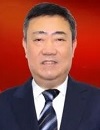 Han Yongjiang: Accelerate the development of nuclear technology application industry
Han Yongjiang: Accelerate the development of nuclear technology application industry
Han also said that nuclear technology application is closely related to nearly one-third of the 43 manufacturing industries of the national economy. It has also promising prospects in fields such as medicine and agriculture. The deep integration of the nuclear technology application into the national economy is not only crucial for unleashing the economic growth potential but also supports the ecological governance and the improvement of people livelihoods. What is more, integrating the nuclear technology application industry into the global economy can contribute to the high-quality development of the Belt and Road cooperation, facilitating the prosperity of both domestic and international markets.
Lu Tiezhong: Nuclear energy green attribute should be certified
Physical startup of Ruppur-1 may occur in December - Likhachev
NPCIL may consider PHWR-220 construction
 South Africa - a new energy strategy
South Africa - a new energy strategy
It is worth noting that the first consideration (about the locations of the SMR) may be very important for the conditions of South Africa.
The plan recognizes the existence of significant capacity constraints on power transmission in several regions of the country. Thus, in the period from 2013 to 2022, only about 4,000 km of transmission lines were built, while more than 14,000 km of transmission lines must be built by 2032.
Small modular reactors, however, will not be able to cover the needs of South Africa for new capacities if this country decides to finally start nuclear construction.
The new version of the IRP plan proposes five scenarios for the development of South African energy until 2050.
New nuclear facilities appear only in one of them,
 The AUKUS and Article 14: Challenges Ahead
The AUKUS and Article 14: Challenges Ahead
The AUKUS project if it goes ahead to completion in its present form of secrecy would set a precedent in the absence of agreed parameters and agreed understandings of the Board of Governors and Member States.
Also, thus far, more than eighteen months since the announcement of the AUKUS agreement there have not been any technical, policy or legal briefings or consultations on Article 14 involving the Secretariat, AUKUS parties and Member States.
This is a significant break with past Agency practice of open-ended consultations on matters concerning interpretation, implementation or strengthening of Agency safeguards.
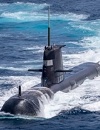 AUKUS - note verbale from China
AUKUS - note verbale from China
China has taken note of the recent Joint Leaders Statement on AUKUS issued by the US, the UK and Australia. China expresses its grave concern and firm opposition to the continued advancement of nuclear submarine cooperation by the AUKUS partners, which is purely out of their own geopolitical interests, disregarding concerns of the international community.
At the same time, China is seriously concerned about the IAEA Director General Statement in Relation to the AUKUS Announcement, and firmly opposed to the US, the UK and Australia coercing the IAEA Secretariat into endorsing their nuclear submarine cooperation by making safeguards exemption affangements on that cooperation.
The AUKUS submarine cooperation has fully exposed...
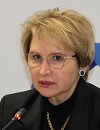 AtomExpo-2022: electric propulsion as a new paradigm
AtomExpo-2022: electric propulsion as a new paradigm
Within the framework of the forum, round tables were organized in various areas. One of it was held under the title Electric propulsion as a new paradigm for industry development, and the briefing for journalists was held after the event.
Electric propulsion is not the most relevant topic for the nuclear industry, and this was evident from the composition of journalists who asked questions, many of whom represented either general political or specialized automotive media.
At difficult times, large state-owned companies and corporations must take on government tasks. The restoration of the Russian automotive industry is one of such serious and important tasks, and the TVEL company...
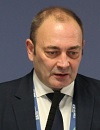 AtomExpo-2022: raw materials for NFC
AtomExpo-2022: raw materials for NFC
On November 21-22, 2022, the XII ATOMEXPO-2022 International Forum was held at the Sirius Center in Sochi. The forum was attended by over 3,000 specialists and guests from Russia, as well as 65 countries of the near and far abroad: representatives of business, government agencies, international organizations.
Several round tables were organized within the framework of the forum. One of it was devoted to the issues of raw materials for nuclear energy.
A characteristic feature of the current stage of development of the nuclear industry is a rational approach to the use of natural uranium resources. The centrifuge technologies have made the re-enrichment of depleted uranium real and commercially effective, and the...
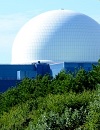 CGN is being forced out of Britain
CGN is being forced out of Britain
Chinese nuclear giants CNNC and CGN have a lot in common with Rosatom in their structure, however, unlike the Russians, their portfolio of foreign orders for the construction of nuclear units can be said to be empty.
From this point of view, the units built by CNNC in Pakistan can be mentioned as the only Chinese success, but it is difficult to call it a victory by the ultimate rating, since only Chinese companies can build nuclear power plants in Pakistan due to the twists of international law.
Chinese analysts have never said out loud the strategy that should have been chosen by the sworn friends of CNNC and CGN to repeat the foreign successes of Rosatom. One can restore the adopted strategy. studying the ways and actions of Chinese corporations.
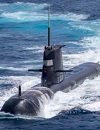 IAEA should not become stage of political manipulation
IAEA should not become stage of political manipulation
The recent International Atomic Energy Agency (IAEA) Board of Governors Meeting decided through consultation for the fourth time to set a separate, formal topic on the transfer of nuclear materials in the context of AUKUS nuclear submarine cooperation and its safeguards in all aspects under the Treaty on the Non-Proliferation of Nuclear Weapons (NPT). IAEA members expressed their serious concerns over relevant issues regarding trilateral cooperation.
The nuclear submarine cooperation among US, UK and Australia created a dangerous precedent of nuclear weapon countries illegally transferring huge amounts of weapon-grade nuclear materials to non-nuclear weapon countries, which is a serious violation of NPT...
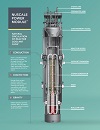 NuScale - waste controversy
NuScale - waste controversy
This time, a group of authors acted as critics, among whom stands out Allison M. Macfarlane, who headed the US Nuclear Regulatory Commission (NRC) for two and a half years.
In a journal called Proceedings of the National Academy of Sciences they published an article analyzing the amount of nuclear waste that will be generated in small modular reactors.
It is worth noting that in the United States, this concept includes not only radioactive waste, but also spent nuclear fuel, because in this country today it is not supposed to close the nuclear fuel cycle.
Small modular reactors (SMRs; i.e., nuclear reactors that produce <300 MWelec each) have garnered attention...
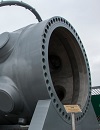 VVER and its future
VVER and its future
Russia has adopted a strategy providing for the formation of two-component nuclear power with fast and thermal reactors. And this means that the VVER technology will remain in our country.
Moreover, according to the accepted development scenarios, the fleet mode units with generation III+ VVER will be introduced in Russia until 2038. The fleet mode units here are understood to be units with VVER-TOI, or rather, with updated VVER-TOI with increased consumer attractiveness and competitiveness.
Further development of the VVER line - the VVER-S with spectral regulation, and the first spectral VVER will also be the first modern VVER of average power of 600 MWe.
After its appearance, spectral VVERs will be able to...
RAOS Project Oy considers Fennovoima reasons for terminating the Hanhikivi 1 delivery contract unfounded
 Vietnam should return to NPP construction program - experts
Vietnam should return to NPP construction program - experts
Vietnam must return to nuclear power plans by 2030 if the country is to meet its climate commitment to achieve carbon neutrality by 2050.
This is the words of the former head of the Vietnam Institute of Energy Nguyen Manh Hien. He voiced this opinion at National Clean Energy Forum.
Restarting the NPP program by 2030 is the only way to achieve our carbon neutrality targets by 2050, as promised at the COP26 forum, the expert said.
In 2009, Vietnam adopted a plan for the development of nuclear energy and it was supposed to build at least two nuclear power plants, one of them with Russian reactors.
However, in 2016 the country postponed the nuclear plan...
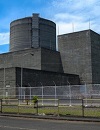 Philippines - discussion of deadlines
Philippines - discussion of deadlines
Two officials of the Department of Energy of the Philippines, who spoke with reporters, are confident that the country is able to start implementing nuclear energy projects in three years, if the next government considers nuclear energy a priority goal.
This is stated in the publication in Philstar.com.
Recall that at the end of February 2022, Philippine President Rodrigo Duterte signed Executive Order No.164 recognizing the role of nuclear energy in the country energy balance.
It is too late for the current government to do anything in the nuclear direction, since new presidential elections will be held in about a month, in which Duterte does not take part.
Question of choosing between Belene and Kozloduy is incorrect - Yanko Yanev
 Stealthy British success of Chinese Dragon
Stealthy British success of Chinese Dragon
The Chinese HPR-1000 (Hualong One) project was certified in Britain in February 2022. Not so long ago, this news would have become the event of a year, if not a decade, but now it has gone almost unnoticed.
Britain is a rare customer these days. It has the needs and desire to build new nuclear power units, it has financial resources and a national regulatory system that is not burdened with ties with supranational superstructures such as the European Union, and it does not have its own projects for third-generation nuclear reactors.
Therefore, one should not be surprised that literally all developers of modern reactor projects are interested in the possibility of certifying their projects in Britain.
Certification in Britain is a British-style confusing process.
The Director General of the IAEA called the negotiations with Iran inconclusive
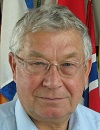 Global Analysis of Basic Problems of Full-Scale Nuclear Power
Global Analysis of Basic Problems of Full-Scale Nuclear Power
This critical analysis of the history, state, and prospects of development of modern nuclear technologies shows that nuclear energy market has practically monopolized the design and construction of only one type of reactors (95% of NPPs under construction use pressurized water reactors), which necessitates training of focused specialists involved in the construction and operation of those nuclear power plants.
One can say that the nuclear industry got engaged in premature capitalization of reactor science that was not properly developed, at a too infant age. We hurried to force nuclear power into the locomotive level of thermodynamics, working at the lowest parameters in modern power industry.
As Academician Pyotr L.Kapitsa wrote in 1955, it is impossible to create competitive new nuclear power units without changing the scientific and technical principle of converting nuclear energy into electric energy.
Achieving a full-scale level of nuclear power, capable of solving social, economic and environmental challenges...
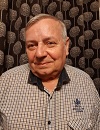 Reincarnation of Nuclear Science
Reincarnation of Nuclear Science
This analysis of the history of civil nuclear power shows that nuclear science experiences a severe crisis of development.
While the fulfillment of nuclear power programs was based on the conversion of defense equipment in combination with conventional energy in the 1950s- 1960s, and the initial stage of its development focused on solving internal problems such as nuclear and radiation safety, efficient utilization of fuel, management of spent fuel and radioactive waste, non-proliferation, etc., conventional energy has implemented - in a competitive environment - the ways to improve economic efficiency and environmental sustainability.
Modern conventional energy has fundamentally...
China needs to have its own isotope production to ensure supply stability
 The main nonproliferation and safeguards challenges facing the small modular reactors
The main nonproliferation and safeguards challenges facing the small modular reactors
In recent years, the not yet very familiar acronym SMR (small modular reactor) has become a new development trend for nuclear power around the world.
The advantages of SMRs are quite obvious - there are fewer requirements to the power systems, in which they will work, lower cost, they can be built much faster, and the whole set of equipment will be manufactured in factory conditions.
Since a fundamental objective for the development of this technology is newcomer countries, the principal requirement for all designs of small modular reactors will be to minimize the potential for proliferation and terrorist activities through proliferation-resistant design approaches in combination with IAEA and other safeguards.
Despite the benefits, small modular reactors also have disadvantages. In this paper we want to highlight and explore how SMRs challenge the existing nonproliferation regime. And how various aspects of SMR designs such as: enrichment, fissile material...
 WANO encourages governments to ensure export controls do not compromise nuclear safety
WANO encourages governments to ensure export controls do not compromise nuclear safety
The World Association of Nuclear Operators (WANO) is encouraging governments worldwide to ensure that national export control laws do not adversely affect WANO ability to maximise the safe operation of commercial nuclear power plants.
Export controls ensure that goods, equipment and technical information exported from a country or area do not contribute to the proliferation of nuclear weapons, and also protect national and international security by restricting access to sensitive nuclear technologies, materials and capabilities.
However, some nations export controls arrangements are impacting the ability of WANO to conduct activities focused on the safe operation of existing commercial nuclear power plants.
Brazil and USA could cooperate for small reactors - minister
 Matthew Bunn: we can still work together
Matthew Bunn: we can still work together
Well, I think Russia and the Unites States still have strong common interests in nonproliferation. Even after the U.S. sanctions in 2014 we continued to work together on the Iran nuclear deal. Unfortunately the Trump administration has pulled out of that deal.
There is some discussion and a little cooperation on North Korea and implementation of the United Nations sanctions on North Korea. It is my hope that North Korean negotiations will move forward and will ultimately involve not just the Unites States and North Korea, but also Russia, China, Japan, and South Korea. We will see if it evolves in that direction.br> I think we need to work together on the preparation for the 2020 NPT Review. Traditionally, the nuclear weapon states have had a common position on Article VI.
 Victor Murogov: Theses of simplified analysis
Victor Murogov: Theses of simplified analysis
If we talk about the history of the nuclear science and technology, which determined the creation and the development of nuclear weapons and, then, nuclear power, we must return more than 100 years ago, in the early 20th century.
 New Book of Victor Murogov
New Book of Victor Murogov
Owing to lucky stars the author has the opportunity to be involved in the processes reflected both from inside, having worked his way up from a research officer to the head of the country largest research center, i.e. SRC RF IPPE (Institute of Physics and Power Engineering, Obninsk) and outside, working as one of IAEA senior officials in Vienna, Austria (International Atomic Energy Agency, a worldwide governmental UN organization in charge of peaceful development of nuclear technology and science). Accordingly, the collection contains the following sections indicative of the author interests and views:
 IAEA International Project on Innovative Nuclear Reactors and Fuel Cycles (INPRO). Scientific-Technical Reminiscences.
IAEA International Project on Innovative Nuclear Reactors and Fuel Cycles (INPRO). Scientific-Technical Reminiscences.
One could see that the third item corresponds to the third task specified by the IAEA Secretariat for INPRO. However, the INPRO limitation by that task as the primary objective from the very beginning was turning INPRO into an appendage to the GIF-4 Project, which was intensely lobbied by the US starting from 2000 (via NEA - Nuclear Energy Agency - as an analogue of the IAEA Secretariat). We were of the opinion, that both projects - INPRO and GIF-4 - should complement each other and should have a common strategic mission: evaluation and feasibility of full-scale development of nuclear power in the future. INPRO could be responsible for conceptual requirements for nuclear power (NPPs and NFCs) while GIF-4, for particular fulfillment of those requirements. All this demands equal support for both projects from leading nuclear nations - donors of innovative technologies. We told Mr. Moniz just about it. And in the future things went on exactly this way. Instead of antagonism, we achieved close interaction and consolidation of political and coordination committees for better exchange of information. More than that, after the Project had been entered into the regular program, representatives of leading nuclear (including western) nations headed the INPRO Section.
 LEU for U.S. tritium: rethinking agreements
LEU for U.S. tritium: rethinking agreements
The threat of the LEU shortages for tritium production could push the United States not to revise but to rethink international agreements involving the United States, which are imposing restrictions on the use of enriched uranium produced using imported technology.
 LEU for U.S. tritium: DoE plans
LEU for U.S. tritium: DoE plans
In the near to medium term, the Department of Energy sees three sources of obtaining the LEU for the tritium producing. In fact, they are all somehow tied to stocks.
The TVA company TVA, the tritium producer, has a valid contract with USEC (its new name is Centrus), under which the latter undertook to supply the LEU for these purposes until mid-2015 financial year. It is obvious that supplies under this contract are provided now from the USEC inventory.
 LEU for U.S. tritium: enrichment plants in the USA
LEU for U.S. tritium: enrichment plants in the USA
Thus, none of the enrichment plants operating or planned for construction in the United States will be able to produce the non-obligated LEU. This conclusion is valid for the case if the DoE will not be making efforts to bring to commercial application the American Centrifuge program.
 LEU for U.S. tritium: HEU and LEU for military
LEU for U.S. tritium: HEU and LEU for military
USEC is the only company to enrich uranium using US technology. In May 2013 the company ceased work on the last commercial enrichment plant Paducah. Company's financial position has deteriorated significantly. In March 2014 it was accepted the conditions of chapter 11 of the United States Bankruptcy Code, providing for the reorganization of the company.
Difficulties arising for USEC questioned the fate of the American program of creation of centrifuges for commercial use - American Centrifuge. This was the program for which the company spent a total of 2.5 billion dollars. In April, the Department of Energy transfers temporarily the control of the project to the Oak Ridge National Laboratory (ORNL). The ultimate fate of the project has not yet been determined.
Experts rectify the malfunctions of the Kudankulam NPP turbine
Experts Lack Evidence to Assess Lockheed Nuclear Fusion Project
World Community Should Cooperate on Eliminating Nuclear Weapons: Expert
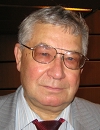 History of the Creation of the International Union of Veterans of Nuclear Energy and Industry (IUVNEI)
History of the Creation of the International Union of Veterans of Nuclear Energy and Industry (IUVNEI)
The initiative to found the IUVNEI was supported by the nuclear community.
A vast and varied experience has been accumulated in all the development stages of nuclear power engineering, starting from the task assignment, upon that each country solved it in its own way, that is why the achievements and failures are so peculiar for each country. In addition, taking into account the traditional closed nature of the industry, few of them have become a property even of specialists.
In the context of the renaissance of nuclear power engineering development in the 20 century it is very important to collect, compile, and distribute all the positive and negative experience mainly in the countries which have never been involved in this industry and, therefore, having no scientific and educational base.
At the present time, taking into account the generation gap, only veterans who have passed all the development stages of the industry, in each country under different starting, economical, and political conditions, are able to compile and transfer this experience to the new generation.
UN Secretary General Urges Nuclear-Weapon-Free States to Remain This Way
Allegation of INF Treaty Violation Part of US Anti-Russia Campaign - military expert
Emerging Economies to Increase Use of Nuclear Energy to Meet Power Demand Ц Report
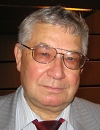 The ISTC Responsible Science Program and Subprogram Culture of Nuclear Nonproliferation
The ISTC Responsible Science Program and Subprogram Culture of Nuclear Nonproliferation
The dual-use nature of nuclear technology consisting in the potential for its application equally in peaceful and military sphere is the basic contradiction for the existing nuclear nonproliferation regime and comprehensive development of the nuclear power and nuclear fuel cycle.
The associated antagonism between the need for the development of civil nuclear power, extension of countries range and areas of peaceful application, on the one hand, and the risk of transferring nuclear technologies and fissile materials that could be applied in the military sphere, on the other hand, defines the principal threat to the nonproliferation regime.
Moreover, the tension of the situation in nuclear nonproliferation at the beginning of the new millennium coincided with a new cycle of renewed interest to nuclear power as well as to plans and efforts focused on further development of innovative technologies (small-size nuclear power plants for developing countries, breeder reactors with closed nuclear fuel cycle with reprocessing and recycling of fissile materials, high-efficiency technology of centrifugal enrichment, etc.)...
World Energy Investment Needs to Grow to $48 Trillion by 2035 - IEA
US Fuel Ineffective in Ukrainian Nuclear Plants
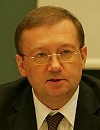 Russia Seeks CTBT Early Entry Into Force
Russia Seeks CTBT Early Entry Into Force
Russia is a strong advocate of the early entry into force of the Comprehensive Nuclear Test Ban Treaty, which is to become an essential part of the international legal security system and an important link to the other nonproliferation and disarmament instruments. We strongly believe that it has the potential to become an important confidence building measure.
At present, 183 states have signed the Treaty and, as of April 9, 2012, 161 have ratified it. However, 17 years since the CTBT opened for signature, the prospects for a full-scale launch of the Treaty remain uncertain, which gives cause for serious concerns. We believe that special responsibility for the CTBT future lies with the remaining 8 states among the List of 44, which have to ratify the Treaty in order for it to come into force. Russia urges these countries to join the CTBT as soon as possible and without preconditions.
All states that support the CTBT must doubtless continue their efforts to promote the Treaty and build up positive mass on the way to its universalization and early entry into force.
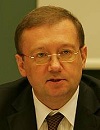 Russian View on the Non-Proliferation of Nuclear Weapons
Russian View on the Non-Proliferation of Nuclear Weapons
The preparatory committee for the 2015 NPT review conference took place in Geneva on April 22-May 3.
Russia views strengthening the NPT regime as a crucial task, and considers it, unquestionably, a foreign policy priority. We believe that the Treaty realization and consolidation serves the interests of all states.
Before the conference, the five NPT nuclear-weapons states met in Geneva on April 18-19, under the Russian Federation chairmanship. They reviewed the progress made towards fulfilling the commitments made at the 2010 NPT review conference, and continued discussions on issues related to all three pillars of the NPT: non-proliferation, the peaceful use of nuclear energy, and disarmament. The participants issued a joint statement which was submitted as a preparation committee document at the NPT review conference.
One of the most serious issues on the agenda of the NPT review process is the creation of the nuclear weapons free zone in the Middle East.
 Church vs. Nukes: The Dilemma of a Secret Russian Town
Church vs. Nukes: The Dilemma of a Secret Russian Town
Sarov disappeared from Soviet maps in 1946, transformed by fiat from a minor provincial town into a key site for the research and development of nuclear weapons Ц some of which stand on display in a strict-ruled museum. The location was ideal: not too far from Moscow, hidden by woodland, but with functional buildings already in place.
Some of those buildings had once belonged to the sixth largest monastery in pre- revolutionary Russia. Its bell tower still dominates the skyline, but has no bells: It survived only because it was topped with television transmitters, which were removed just last year. The town main street barrels through the monastery 18th- century compound. The main churches were blown up by Soviet authorities in the 1950s, a quarter-century after the cloister had been closed and converted Ц first, to a juvenile prison, then to a military factory. One of the churches left standing served in Soviet times as a theater.
Today, Sarov Ц best known by its longest-lasting Soviet code name, Arzamas-16 Ц prides itself on facilities such as Russian largest supercomputer.
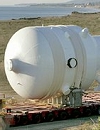 San Onofre Infantile Disorder
San Onofre Infantile Disorder
But the struggle of trade unions may not lead to anything, and the revival of the American nuclear imdustry is not moved an inch. Not surprisingly, the owners of San Onofre NPP had to apply for the new steam generators abroad, namely in the Japanese corporation Mitshubishi Heavy Industries (MHI).
From the Japanese plant workers it was requested to produce and deliver new steam generators capable to work reliably at least 20 years or more. Terms of the license for San Onofre NPP units completed in 2012-2013 to achieve 40 years of service. But the owners of the station planned to extend to 20 years, and then, perhaps, another 20.
MHI was actively took up the order. But at first there were warning signs. During the inspection two SGs for third unit in spring 2010, it was revealed the cracks in the welds. The cracks in operating conditions will inevitably become a hotbed of corrosion damage. Results of the inspection were the subject of heated discussions with customers and regulators.
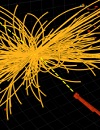 The God Particle cometh
The God Particle cometh
The biggest news in the science community is still the Higgs boson breakthrough - why, it even has its own song!
Of course, I could take time to celebrate the heroes here, the scientists who may have just discovered what is known as the God Particle - and seriously advanced physics.
Instead, I am going to do two things: make fun of the end-of-the-world idiots and, simultaneously, validate doomsday theories. Because itТs been that kind of week.
You see, the European Organization for Nuclear Research (CERN), which is responsible for this important scientific development, originally came under fire for allegedly hastening the end of the world. Anyone remember the cries of they are going to cause a black hole to rip up apart Earth!!! when their Large Hadron Collider first went online? The LHC is what allowed scientists to glimpse that elusive boson just now - if you have not been paying attention.
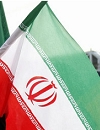 The Baghdad Chapter in the Iran Saga
The Baghdad Chapter in the Iran Saga
One more round of talks will be held in Moscow on June 18-19 in an attempt to find common ground. There is no reason to dramatize the situation. EU High Representative for Foreign Affairs and Security Policy Catherine Ashton said that Iran and P5+1 still seek to make progress. Tehran voiced its readiness to limit enrichment activities.
In light of the failure of the sides to forge an agreement in Baghdad, much will depend now on the success of inspectors in Iran and the EUТs ability to provide attractive financial and economic incentives to Iran.
If the sides make progress in these areas, they will forestall the escalation of the Iranian nuclear crisis, giving hope that a peaceful settlement is possible. Otherwise, the risk of a military scenario will increase substantially, and any use of force could ignite a regional war with unpredictable consequences.
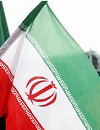 See You in Nuclear Tehran
See You in Nuclear Tehran
If someone wanted to back out of the April 13-14 meeting between Iran and the P5+1 group of international mediators to discuss Iran nuclear program, here is an excuse Ц Tehran has suddenly asked to move the venue from Istanbul to Baghdad.
Now the question is whether the key participant in the talks, the United States, wants talks to go forward and why. On the one hand, one gets the impression that the Obama administration considers any form of communication with Tehran to be distasteful and would like to have an excuse to back out of talks. But, on the other hand, failing to produce any results is no good either.
It became clear from an April 3 interview given by Deputy Foreign Minister Sergei Ryabkov that the future of the Istanbul talks is vague Ц unexpectedly, he could not confirm the time and venue of the meeting.
U.S. Secretary of State Hillary Clinton has already said that the talks will take place in Istanbul, but now Tehran has objected to the venue.








































